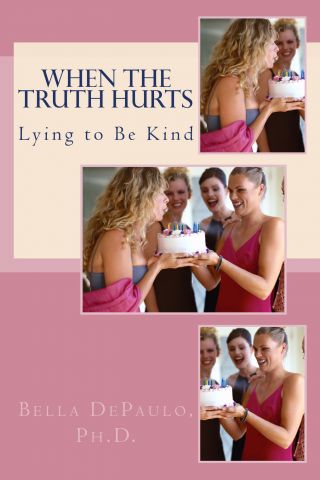Why Are We so bad at Detecting Lies?
Surprise! We’re not using the wrong cues.
This post is in response to 9 Ways to Tell Who's Lying to You by Susan Krauss Whitbourne
People are pretty lousy lie detectors. In ordinary social interactions, when all we have to go by is what the other persons are saying and how they are saying it, our judgments of whether someone is lying or telling the truth are correct only a little more often than chance. My colleague Charlie Bond and I discovered that when we summarized the results(link is external) of all of the studies that had ever been done on the topic, in which more than 24,000 people had participated. By chance, accuracy would have been 50 percent; the average accuracy across all of the studies was 54 percent.
Peruse any popular website that features social science research and sooner or later you will come across an article or blog post with a title such as “How to tell when someone is lying.” You can find those articles in scholarly journals, too. I’ve written some myself, including a massive review. (The version laden with jargon and statistics is here(link is external); the readable version is here(link is external).)
Often, when people promise to tell you about cues to deception, what they are implying is that you aren’t that great at detecting lies because you don’t know what to look for. You don’t know how people really do behave differently when they are lying compared to when they are telling the truth.
But is that really true?
If you ask people directly to tell you how they know when people are lying, they will often give you answers that are way off base(link is external). For example, they seem sure that liars won’t look you in the eye, or that they fidget a lot, when research shows that those behaviors are not very useful indicators of whether a person is lying.
There is a better way to know what behaviors people see as relevant to deception, and that’s to look at the cues they rely on when they make actual judgments of whether a person is lying or telling the truth. In the typical study, people watch a video of people who are lying or telling the truth, and they record their judgments of the truthfulness of each person on the video. Researchers can then correlate the behaviors of the persons on the video with the judgments of the viewers. For example, when people on the video smile a lot, are they more or less likely to be judged as lying?
Such studies tell us which behaviors are judged to be indicative of deception, not which behaviors really are cues to deception. In a comprehensive review article, Hartwig and Bond found a number of cues that are important to people’s judgments of deceptiveness.
People Will Think You Are Lying If You…
#1
…tell stories that are not very compelling. If you tell stories that do not sound plausible or logical, people will probably think you are lying. If you don’t seem very involved in what you are saying, if you are not very direct, same thing – you are likely to be judged as deceptive. Coming across as ambivalent or indifferent or uncertain is also a credibility-killer.
#2
…seem less than forthcoming. If you are stingy with details, or if you refuse to discuss certain topics, don’t be surprised if people think you might have something to hide.
#3
…seem tense. People who seem nervous are generally less likely to be believed than people who do not seem tense.
#4
…are not very positive or pleasant. If you are unfriendly or uncooperative or if you have an unpleasant facial expression, you are stacking the deck against your own credibility. People are less likely to believe you. On the other hand, if you have a baby face, or if you seem competent, people are more likely to believe that you are telling the truth.
Are the Cues People are Using the Cues They Should Be Using?
The cues people should use to judge deceptiveness are the ones that really do separate the liars from the truth-tellers. Hartwig and Bond (2011) looked at results for more than 50 cues and found that for about two-thirds of them, people were using the cues they should have been using. When there were discrepancies, people were relying on particular cues more than they should have been. For example, people’s faces really do look a little less pleasant when they are lying than when they are telling the truth, but those who are making judgments about deceptiveness think that facial pleasantness matters more than it really does.
What never happened is that people, on the average, were using cues the wrong way. They might make too much of an unfriendly person, but they don’t head down the exact wrong track by thinking that people acting friendly are significantly more likely to be lying than people acting unfriendly. They get it that it’s the unfriendly faces that are, on the average, less likely to be trustworthy.
It is also possible to look at the overall pattern of the cues that people used in their deception judgments and compare that to the pattern of cues that people should be using. Again, those analyses showed that people are generally using the right cues. The correlation between the two sets of cues is at least .59. That’s not a perfect relationship but it is pretty good.
If People Are Using the Right Cues, Why Aren’t They Better Lie-Detectors?
Cues to deception are not that useful. There are ways that people act differently when they are lying than when they are telling the truth (that’s what a cue to deception is), but the differences are not all that big or reliable. So, for example, on the average, liars seem more nervous than truth-tellers. But the difference is unimpressive in its size. And, there are lots of exceptions. Sometimes liars do not seem particularly nervous. Also, people can be nervous for reasons that have nothing to do with whether they are lying or telling the truth. Maybe they are worried about being disbelieved. Or maybe they are stressing about something else entirely.
If you want to know whether someone is lying, you can’t just sit back and observe their verbal and nonverbal behaviors. If you are a detective, you may need to learn how to ask the kinds of questions that trip up liars, getting them to reveal more than they should. Or you just need to go out and find more reliable evidence.
Reference: Hartwig, M., & Bond, C. F. Jr. (2011). Why do lie-catchers fail? A lens model meta-analysis of human lie judgments. Psychological Bulletin, 137, 643-659.

Note: Interested in what people do when the desire to be kind clashes with the value of telling the truth? I wrote about it in When the truth hurts: Lying to be kind(link is external). You can get a preview of the contents of the brief book here(link is external).



